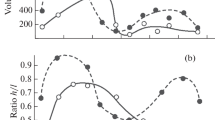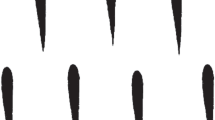Abstract
We propose a hypothetical visual field overlap (VFO) model for shoaling behavior. While solitary individuals have the disadvantage of a substantial blind zone to their rear, the overlapping visual fields among shoal members allows the shoal to collectively view nearly 360°. A highly polarized shoal (i.e., a school) would be less advantageous than randomly oriented shoals because a substantial area blind to all school members (common blind zone) would occur at some distance behind the school. However, in situations where fishes must orient in one direction, the visual fields of individuals in the school overlap such that the common blind zone is considerably farther behind than the blind zone of any particular fish. A simple geometric relationship between school width, the blind angle, and the distance to the common blind zone predicts that larger schools can detect predators at a greater distance than smaller schools. Additionally, the model provides a novel explanation for the nearly universally observed tendency for fish to school together with like-sized individuals. Finally, the effect of school shape on the visual field overlap pattern would have a strong impact on predator–prey interactions. However, our model does not directly take into account the range of visibility or social interaction affects and applies only to small groups. The VFO model suggests that schooling may have arisen as an adaptation to enhance feeding efficiency by reducing the need for individual vigilant behavior while oriented into the current for feeding. We believe the VFO model promises to provide insight into the behavioral ecology of shoaling fishes and that it is highly amenable to both field and laboratory testing.







Similar content being viewed by others
References
Aoki I, Inagaki T, Long LV (1986) Measurements of the three-dimensional structure of free-swimming pelagic fish schools in a natural environment. Bull Japanese Soc Scientific Fish 52(12):2069–2077
Bertram BCR (1978) Living in groups: predators and prey. In: Krebs JR, Davies NB (eds) Behavioural ecology. Balckwell, Oxford, U.K., pp 64–96
Bogatyrev PB (1970) Certain elements of the spatial vision in fishes. p. 192-206. In: Biological Basis for Controlling Fish Behavior. Manteyfel BP (ed) Evolutionary Morphology and Animal Ecology. Akad. Nauk SSSR, Inst., Moscow. 304 pp. Transl. 1978. NTIS PB 283 049-T
Cullen JM, Shaw E, Baldwin HA (1965) Methods for measuring the three-dimensional structure of fish schools. Anim Behav 13(4):534–543
Dunbrack RL, Dill LM (1984) Three-dimensional prey reaction field of the juvenile coho salmon (Oncorhynchus kisutch). Can J Fish Aquat Sci 41:1176–1182
Gaillard F, Roussel H (1986) The visual field of a North African toad Bufo mauritanicus. Naturwissenschaften 73(3):158–159
Hall SJ, Wardle CS, MacLennan DN (1986) Predator evasion in a fish school: test of a model for the fountain effect. Mar Biol 91:143–148
Hasegawa E, Kobayashi H (1988) Mathmatical model in relation to the significance of fish schooling Nippon Suisan Gakkaishi. Bull Jap Soc Sci Fish 55(2):371
Hughes NF, Dill LM (1990) Position choice by drift feeding salmonids: model and test for Arctic grayling (Thymallus arcticus) in subarctic mountain streams, interior Alaska. Can J Fish Aquat Sci 47:2039–2048
Huth A, Wissel C (1994) The simulation of fish schools in comparison with experimental data. Ecol Mod 75(76):135–145
Katzir G, Martin GR (1994) Visual fields in herons (Ardeidae): panoramic vision beneath the bill. Naturwissenschaften 81(4):182–184
Luecke C, O’Brien WJ (1981) Prey location volume of a planktivorous fish: a new measure of prey vulnerability. Can J Fish Aquat Sci 38:1264–1270
Magurran AE, Oulton W, Pitcher TJ (1985) Vigilant behaviour and shoal size in minnows. Zeitschrift fur Tierpsychologie 67:167–178
Meyer TL, Cooper RA, Langton RW (1979) Relative abundance, behavior, and food habits of the American sand lance, Ammodytes americanus, from the Gulf of Maine. Fish Bull 77(1):243–253
Milinski M (1986) Constraints placed by predators on feeding behaviour, Chapter 9. In: Pitcher TJ (ed) The behavior of teleost fishes. The Johns Hopkins University Press, Baltimore, pp 236–252
Moroney MK, Pettigrew JD (1987) Some observations on the visual optics of the kingfishers (Aves, Coraciformes, Alcedinidae). J Compo Physiol A 160(2):137–149
Nicol JAC (1989) The Eyes of Fishes. Clarendon Press, Oxford
O’Brien WJ, Showalter JJ (1993) Effects of current velocity and suspended debris on the drift feeding of Arctic Grayling. Trans Am Fish Soc 122:609–615
Partridge BL (1981) Internal Dynamics and interrelations of fish in schools. J Compar Physiol 144(3):313–325
Pitcher TJ (1973) The three-dimensional structure of schools in the minnow, Phoxinus phoxinus (L.). Anim Behav 21:673–686
Pitcher TJ (1986) Functions of shoaling behaviour in teleosts. In: Pitcher TJ (ed) The behavior of teleost fishes, vol 12. The Johns Hopkins University Press, Baltimore, pp 294–337
Protasov VR (1966) Vision and near orientation of fish. Raveh M (Transl), Israel Program for Scientific Translation, IPST No. 5738, United States Department of the Interior, Washington, D.C.
Serebrov LI (1984) Structure and some peculiarities of group interactions of capelin, Mallotus villosus villosus (Osmeridae). J Ichthyology 24(4):16–25
Tamura T (1957) A study of visual perception in fish, especially on resolving power and accommodation. Bull Jpn Soc Sci Fish 22:536–557
Thetmeyer H, Kils U (1995) To see and not be seen: the visibility of predator and prey with respect to feeding behaviour. Mar Ecol Prog Ser 126(1–3):1–8
Trevarthen C (1968) Vision in fish: the origins of the visual frame for action in vertebrates. In: Ingle D (ed) The Central Nervous System and Fish Behavior. University of Chicago Press, Chicago, pp 61–94
Turner GF, Pitcher TJ (1986) Attack abatement: a model for group protection by combined avoidance and dilution. Am Nat 128(2):228–240
Vine I (1971) Risk of visual detection and pursuit by a predator and the selective advantage of flocking behavior. J Theor Biol 30:405–422
Walls GL (1942) The vertebrate eye and its adaptive radiation. Bulletin of the Cranbrook Institute of Science 19:375–376
Wardle CS (1986) Fish behavior and fishing gears. In: Pitcher TJ (ed) The behavior of teleost fishes, vol 18. The Johns Hopkins University Press, Baltimore, pp 463–495
Zaferman ML, Serebrov LI (1989) A geometric model of the distribution of fish in a school. J Ichthyol 27(6):145–148
Author information
Authors and Affiliations
Corresponding author
Additional information
Communicated by E. Goncalves
Rights and permissions
About this article
Cite this article
Rountree, R.A., Sedberry, G.R. A theoretical model of shoaling behavior based on a consideration of patterns of overlap among the visual fields of individual members. acta ethol 12, 61–70 (2009). https://doi.org/10.1007/s10211-009-0057-6
Received:
Revised:
Accepted:
Published:
Issue Date:
DOI: https://doi.org/10.1007/s10211-009-0057-6




